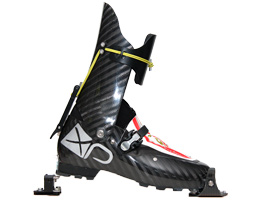Elemental carbon—atomic number 6 (six protons in the nucleus); symbol of “C”; fourth most common element in the universe—is a major component of all living things, plus pencil lead, diamonds, etc. But none of that is useful for making skis.
Sure, everyone knows carbon fiber is used in the construction of skis, boots, poles, and probes (not to mention bike frames and fishing rods). But, did you know that you can buy a carbon-fiber coffee table, toilet1 (10.9 lbs., no shit), or even a complete bathtub2 ($68,000)?
Manufacturing the fibers takes time and energy, which is why it’s so expensive. It starts with the synthetic polymer polyacrylonitrile (like the acrylic used in clothing), which is oxidized under relatively low heat, then heated at much higher temps in an inert gas to carbonize it. That drives off most other elements, leaving about 95-percent carbon. The resulting fibers are stiff (high modulus elasticity), high in high-tensile strength and light.
To construct anything with these fibers, they must be bonded into a matrix. An epoxy resin is added to woven, carbon-fiber fabric or inline fibers during the layup and shaping. Alternatively, “prepreg” carbon fibers—pre-impregnated with the resin—are formed and heated to cure the resin. All this yields a material that, compared to steel, is twice as strong, five times as stiff and a third of the weight.
Manufacturing costs for the material itself should decrease as demand continues to rise. In fact, the U.S. Department of Energy recently launched the Carbon Fiber Technology Facility3, at its Oak River National Lab in Tennessee to improve fuel efficiency in transportation. Another thrust of the project is to adapt the manufacturing process to sustainable carbon sources such as wood pulp. The goal? Halve the cost of carbon fiber production. This, of course, brings that feather-light bidet of my dreams one step closer to reality.
- www.headhunterinc.com/Products/Toilets/carbonfiber.html
- store.carbonfibergear.com
- web.ornl.gov/sci/manufacturing/research/carbon_fiber.shtml
Carbon in the Quiver
From Typical to Out There
DPS PURE3 – dpsskis.com
DPS ups the ante in their Pure3 construction by using “pre-preg” carbon fiber. Pre-preg means the fibers are pre-impregnated with a precise amount of resin during manufacturing to eliminate extra resin, therefore cutting extra weight. The Pure3 models feature a sidewall/sandwich construction surrounding a wood core, with pre-preg carbon to provide structure. Imbedded aluminum strips provide dampness.
VöLKL V-WERKS KATANA – volkl.com
Völkl uses a woven, carbon-fiber fabric throughout the V-Werks Katana, which allows them to reduce core thickness by 60 percent at the tip and tail they claim. Underfoot the core is more standard thickness for added strength and binding retention, but the thinner tip and tail shaves pounds from the construction.
SCARPA CARBON CORE – scarpa.com
Scarpa’s Carbon Core stiffens the lower boot by molding a Pebax or PU shell around a carbon frame. That underfoot carbon extends up the sides of the lower, designed to increase torsional stiffness between the cuff and binding, and the boot sole is bolted on through the carbon frame. Scarpa pioneered the technology in the superlight Alien 1.0—a carbon-cuffed boot that weighs 3 lbs./pair. They’ve since adopted the technology into their Freedom and Freedom SL boots.
PIERRE GIGNOUX PACK ULTIMATE – pierregignoux.fr
Pierre Gignoux pushes the boundary of creativity and materials with a five-ounce binding—that’s per pair. The Tech toes are only compatible with Pierre Gignoux’s full-carbon Ultimate2 boots (2.2 lbs./pair). A quick step onto the toe piece flexes the carbon fiber for binding entry. Exiting requires a simple push on the side lever—speedy for racing. The polymer heel unit flexes for entry and upward release, and rotates for lateral release. All this for only 1900 Euros (about $2,500) for the boot and binding package.















Ahhh, thats interesting. I wonder how the fit feels on these.